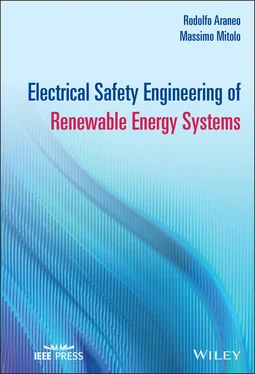Rodolfo Araneo - Electrical Safety Engineering of Renewable Energy Systems
Здесь есть возможность читать онлайн «Rodolfo Araneo - Electrical Safety Engineering of Renewable Energy Systems» — ознакомительный отрывок электронной книги совершенно бесплатно, а после прочтения отрывка купить полную версию. В некоторых случаях можно слушать аудио, скачать через торрент в формате fb2 и присутствует краткое содержание. Жанр: unrecognised, на английском языке. Описание произведения, (предисловие) а так же отзывы посетителей доступны на портале библиотеки ЛибКат.
- Название:Electrical Safety Engineering of Renewable Energy Systems
- Автор:
- Жанр:
- Год:неизвестен
- ISBN:нет данных
- Рейтинг книги:5 / 5. Голосов: 1
-
Избранное:Добавить в избранное
- Отзывы:
-
Ваша оценка:
- 100
- 1
- 2
- 3
- 4
- 5
Electrical Safety Engineering of Renewable Energy Systems: краткое содержание, описание и аннотация
Предлагаем к чтению аннотацию, описание, краткое содержание или предисловие (зависит от того, что написал сам автор книги «Electrical Safety Engineering of Renewable Energy Systems»). Если вы не нашли необходимую информацию о книге — напишите в комментариях, мы постараемся отыскать её.
A reference to designing and developing electrical systems connected to renewable energies Electrical Safety Engineering of Renewable Energy Systems
Electrical Safety Engineering of Renewable Energy Systems
Electrical Safety Engineering of Renewable Energy Systems — читать онлайн ознакомительный отрывок
Ниже представлен текст книги, разбитый по страницам. Система сохранения места последней прочитанной страницы, позволяет с удобством читать онлайн бесплатно книгу «Electrical Safety Engineering of Renewable Energy Systems», без необходимости каждый раз заново искать на чём Вы остановились. Поставьте закладку, и сможете в любой момент перейти на страницу, на которой закончили чтение.
Интервал:
Закладка:
An amazing (and demanding) period of two years of work and dedication started, whose results the authors hope the readers will enjoy.
The authors believe that a book is the ideal means to make it possible to share the results of experience and research with the readers. Many books on renewable energies have been written, yet this book introduces a different view on the topic: it teaches the practitioner (student or engineer) how to ensure electrical safety in renewable energy systems (e.g., when the sun shines, a PV array cannot be turned off).
This book does not want to be the classic academic book for a university course, but it has been written with the intent to marry the experience of the professional engineer with the scientific rigor of the university professor: two ugly beasts that together may have produced an interesting result.
Nowadays, there is a great and unsatisfied demand for electrical engineers, especially in power systems, which now do include renewable energies. This is especially true in light of the global energy transition that we are experiencing: we are walking along a pathway toward a transformation of the global energy sector from fossil-based to zero-carbon footprint. The electric engineer will play a major role since safe electrification is expected to be a critical milestone for decarbonization. There should be no shortage of challenging problems in renewables in the foreseeable future. There will be a clear need for engineers to have both an understanding of the fundamentals of electric safety as applicable to renewables and the creativity to apply this knowledge to problems of practical interest.
This book is for those engineers.
Acknowledgments
It is a pleasure to acknowledge the role of many students in helpful discussions. Prof. Araneo would like to thank Giorgio Mingoli for the phone call in 2004. The authors would like to thank the following persons for providing materials and being available: Giuseppe Mastropieri, Fabio Amico and Massimiliano D’Angelo of REA Advisors, Raffaella De Cupis and Gianfranco De Simone of Ghella, Massimilano Donati of VEI Green, Saverio Spampanato of Secundm Naturam, and Riccardo Cecere of Enel Global Power Generation. Finally, Prof. Araneo finds it difficult to express in words his gratefulness to Prof. Salvatore Celozzi, who provided him with guidance, support, and encouragement during his career.
Prof. Rodolfo Araneo
Roma, Italy, March 28, 2021
Prof. Massimo Mitolo
Irvine, California, March 28, 2021
1 Fundamental Concepts of Electrical Safety Engineering
CONTENTS
1.1 Introduction
1.2 Electric Shock
1.2.1 Ventricular Fibrillation
1.2.2 The Heart-current Factor
1.3 The Electrical Impedance of the Human Body
1.3.1 The Internal Resistance of the Human Body
1.4 Thermal Shock
1.5 Heated Surfaces of Electrical Equipment and Contact Burn Injuries
1.6 Ground-Potential and Ground-Resistance
1.6.1 Area of Influence of a Ground-electrode
1.7 Hemispherical Electrodes in Parallel
1.8 Hemispherical Electrodes in Series
1.9 Person’s Body Resistance-to-ground and Touch Voltages
Example 1.1
1.10 Identification of Extraneous-Conductive-Parts
1.11 Measuring Touch Voltages
References
I shall be telling this with a sigh Somewhere ages and ages hence : Two roads diverged in a wood, and I- I took the one less traveled by , And that has made all the difference .
Robert Frost
1.1 Introduction
The renewable energy sector has been rapidly growing in the past decade [1–3], and so has been the number of accidents involving workers in “green” projects. Statistics in the United States reveal that injuries and death are caused by lack of safety training and safety procedures [4]. The Electric hazard, but also Falls , Struck by and Caught in between hazards, are always present during all photovoltaic, solar thermal, and wind tower construction projects, regardless of the magnitude of the job.
The culture of the safety-by-design [5, 6] seems to be the appropriate response to the increased risk offered by renewable energy systems (RES). RES may challenge the safety of workers because they are generally always live , and the system voltage may exceed 500 V d.c. 1
In addition to safety training and procedures, electrical safety may be conveyed through engineering measures that reduce the risk of electric shock below a threshold that is conventionally deemed acceptable by applicable standards. In fault-free conditions, the basic protection ensures that persons cannot come into contact with parts normally live (i.e., proper insulation of electrical components). In the case of failure of the basic insulation of components, the fault protection ensures defense against electric shock by automatic interruption of the fault current. In some scenarios, the fault protection may be obtained with alternative methods to the fault current interruption.
In general, the safety-by-design of RES [7] is achieved if hazardous energized parts are never accessible, and that equipment/appliances, also referred to as exposed-conductive-parts (ECPs), are never hazardous either under normal operations or in the event of single-faults. In essence, touch voltages and contact durations must be within the magnitudes deemed safe by applicable technical standards and codes.
1.2 Electric Shock
External electrical stimuli applied to the human body can prevent operational skeletal and cardiac muscles from properly operating, as well as destroy bodily tissues by thermal shock.[8]
External a.c. currents with frequency ranging from 50 to 100 Hz of magnitude around 10 mA for adult males and 15 mA for adult females, can override the internal electrical signals from the brain controlling the body muscles, render the person unable to “let go” of an energized part and cause painful muscle contractions.
For d.c. currents, thresholds of let-go cannot be positively defined. The circulation of d.c. current through the body only causes a sensation of warmth, and the person is subjected to painful muscle contractions only during making and breaking of the d.c. current.
Stevens’ Law [9, 10] describes the perceived strength of a physical stimulus as a function of its intensity, expressed in its physical units. According to Stevens’ Law, the perception of electric shock is superlinear with the stimulus, as varies as the 3.5 power of the a.c. voltage applied. The coefficient 3.5 relates the magnitude of the applied voltage to the perceived magnitude of the shock as current through the fingers; thus, a small increase in the applied voltage is perceived as a larger increase in the electric shock.
A 30 mA-current, if interrupted within 300 ms, can cause involuntary muscular contractions but usually no harmful electrical physiological effects. Longer disconnection time, up to 5 s, can cause muscular contractions, difficulty in breathing, reversible disturbances of heart function, but usually no organic damage.
Higher body currents inhibit internal muscle control, prejudicing the function of the muscles involved in the breathing process, thus causing asphyxia.
1.2.1 Ventricular Fibrillation
The ventricular fibrillation (V-fib) [11] is the loss of the normal heart rhythm. The V-fib causes the ventricles to quiver , or fibrillate, instead of contracting normally, preventing the heart from pumping blood and causing cardiac arrest. The ventricular fibrillation is the main cause of death in electric shock accidents.
Читать дальшеИнтервал:
Закладка:
Похожие книги на «Electrical Safety Engineering of Renewable Energy Systems»
Представляем Вашему вниманию похожие книги на «Electrical Safety Engineering of Renewable Energy Systems» списком для выбора. Мы отобрали схожую по названию и смыслу литературу в надежде предоставить читателям больше вариантов отыскать новые, интересные, ещё непрочитанные произведения.
Обсуждение, отзывы о книге «Electrical Safety Engineering of Renewable Energy Systems» и просто собственные мнения читателей. Оставьте ваши комментарии, напишите, что Вы думаете о произведении, его смысле или главных героях. Укажите что конкретно понравилось, а что нет, и почему Вы так считаете.












